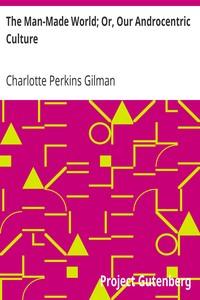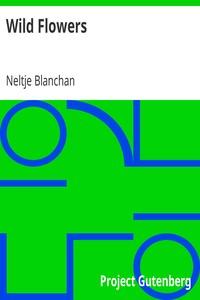Read this ebook for free! No credit card needed, absolutely nothing to pay.
Words: 47293 in 17 pages
This is an ebook sharing website. You can read the uploaded ebooks for free here. No credit cards needed, nothing to pay. If you want to own a digital copy of the ebook, or want to read offline with your favorite ebook-reader, then you can choose to buy and download the ebook.


: The Man-Made World; Or Our Androcentric Culture by Gilman Charlotte Perkins - Women Social and moral questions; Women Social conditions
OUR ANDROCENTRIC CULTURE, or THE MAN-MADE WORLD
Let us begin, inoffensively, with sheep. The sheep is a beast with which we are all familiar, being much used in religious imagery; the common stock of painters; a staple article of diet; one of our main sources of clothing; and an everyday symbol of bashfulness and stupidity.
In some grazing regions the sheep is an object of terror, destroying grass, bush and forest by omnipresent nibbling; on the great plains, sheep-keeping frequently results in insanity, owing to the loneliness of the shepherd, and the monotonous appearance and behavior of the sheep.
To the scientific mind there is special interest in the sequacity of sheep, their habit of following one another with automatic imitation. This instinct, we are told, has been developed by ages of wild crowded racing on narrow ledges, along precipices, chasms, around sudden spurs and corners, only the leader seeing when, where and how to jump. If those behind jumped exactly as he did, they lived. If they stopped to exercise independent judgment, they were pushed off and perished; they and their judgment with them.
As "function comes before organ," we may even give a reminiscent glance down the long path of evolution, and see how the mere act of butting--passionately and perpetually repeated--born of the belligerent spirit of the male--produced horns!
Even the bird, though not a mammal, shows the same mother-love and mother-care, while the father bird, though not a butter, fights with beak and wing and spur. His competition is more effective through display. The wish to please, the need to please, the overmastering necessity upon him that he secure the favor of the female, has made the male bird blossom like a butterfly. He blazes in gorgeous plumage, rears haughty crests and combs, shows drooping wattles and dangling blobs such as the turkey-cock affords; long splendid feathers for pure ornament appear upon him; what in her is a mere tail-effect becomes in him a mass of glittering drapery.
Partridge-cock, farmyard-cock, peacock, from sparrow to ostrich, observe his mien! To strut and languish; to exhibit every beauteous lure; to sacrifice ease, comfort, speed, everything--to beauty--for her sake--this is the nature of the he-bird of any species; the characteristic, not of the turkey, but of the cock! With drumming of loud wings, with crow and quack and bursts of glorious song, he woos his mate; displays his splendors before her; fights fiercely with his rivals. To butt--to strut--to make a noise--all for love's sake; these acts are common to the male.
We may now generalize and clearly state: That is masculine which belongs to the male--to any or all males, irrespective of species. That is feminine which belongs to the female, to any or all females, irrespective of species. That is ovine, bovine, feline, canine, equine or asinine which belongs to that species, irrespective of sex.
In our own species all this is changed. We have been so taken up with the phenomena of masculinity and femininity, that our common humanity has largely escaped notice. We know we are human, naturally, and are very proud of it; but we do not consider in what our humanness consists; nor how men and women may fall short of it, or overstep its bounds, in continual insistence upon their special differences. It is "manly" to do this; it is "womanly" to do that; but what a human being should do under the circumstances is not thought of.
The only time when we do recognize what we call "common humanity" is in extreme cases, matters of life and death; when either man or woman is expected to behave as if they were also human creatures. Since the range of feeling and action proper to humanity, as such, is far wider than that proper to either sex, it seems at first somewhat remarkable that we have given it so little recognition.
A little classification will help us here. We have certain qualities in common with inanimate matter, such as weight, opacity, resilience. It is clear that these are not human. We have other qualities in common with all forms of life; cellular construction, for instance, the reproduction of cells and the need of nutrition. These again are not human. We have others, many others, common to the higher mammals; which are not exclusively ours--are not distinctively "human." What then are true human characteristics? In what way is the human species distinguished from all other species?
Our human-ness is seen most clearly in three main lines: it is mechanical, psychical and social. Our power to make and use things is essentially human; we alone have extra-physical tools. We have added to our teeth the knife, sword, scissors, mowing machine; to our claws the spade, harrow, plough, drill, dredge. We are a protean creature, using the larger brain power through a wide variety of changing weapons. This is one of our main and vital distinctions. Ancient animal races are traced and known by mere bones and shells, ancient human races by their buildings, tools and utensils.
Free books android app tbrJar TBR JAR Read Free books online gutenberg
More posts by @FreeBooks

: Wild Flowers An Aid to Knowledge of Our Wild Flowers and Their Insect Visitors by Blanchan Neltje - Wild flowers North America Botany


: Society's Child (audiofile) by Ian Janis Performer - Folk songs English United States; Popular music 1961-1970






